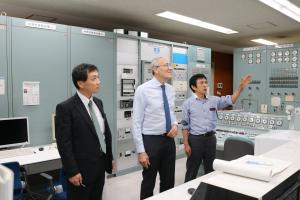Bernard Bigot, the Director-General of the ITER Organization, visited the Institute of Advanced Energy, Uji campus, on 30 September.
Guided by professors from the Institute, he was introduced to the most recent activities of the Heliotron J device whose complex coil system allow researchers to investigate a wide range of magnetic configuration properties. The Director-General was also interested in the dual MV-class accelerator DuET (Dual-Beam Facility for Energy Science and Technology), which simulates fusion-relevant material radiation damage.
Other areas of focus for Kyoto University were also presented to Director-General Bigot, including theoretical and computational fusion research activities on turbulent transport as well as MHD* phenomena. Possible areas of collaboration between the ITER Organization and Kyoto University were discussed, especially as relates to the development of diagnostic and structural materials, plasma turbulence simulation, and the training of young scientists.
Finally, the ITER Director-General was able to see the first ITER Tokamak model made by Kyoto University students Taishi Sugiyama and Kaishi Sakane from Lego bricks. In March 2017, the students had been able to repeat their technical exploit in the lobby of ITER Headquarters, where
the model still stands.
* Magnetohydrodynamics, or the study of the magnetic properties of electrically conducting plasmas (and other fluids).
For more information on Heliotron J and DuET, please visit the Kyoto University website.


